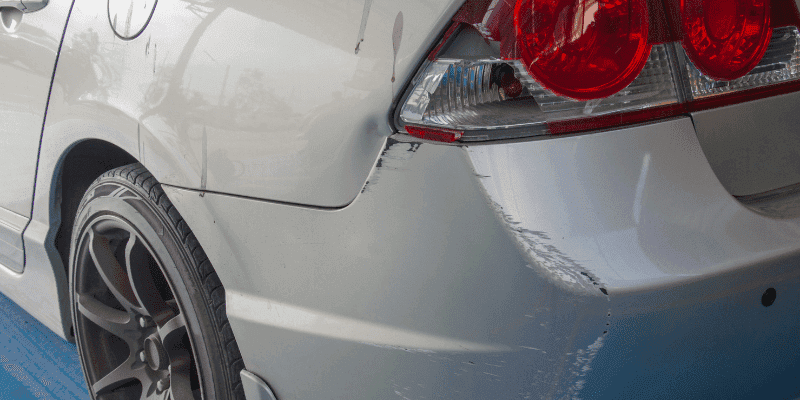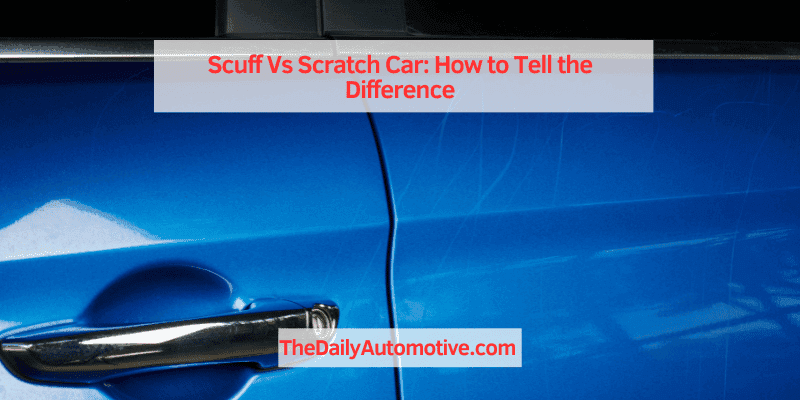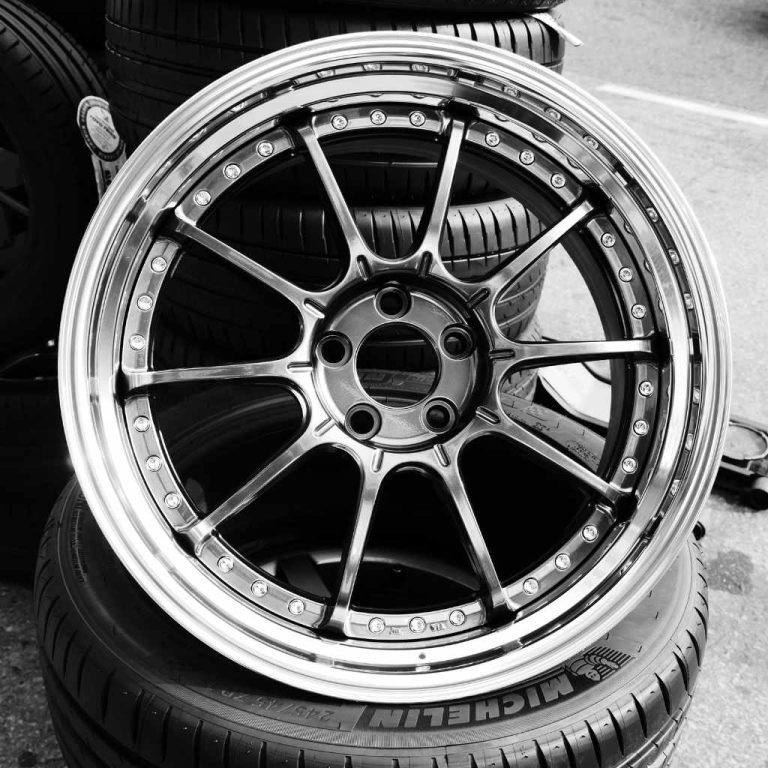Scuff Vs Scratch Car: How to Tell the Difference
A scuff on a car is a superficial mark, while a scratch goes deeper into the paint. Scuffs are lighter and easier to fix than scratches, often requiring simple buffing or waxing.
A scratch, on the other hand, may need touch-up paint or professional repair to restore the car’s appearance. Both scuffs and scratches can detract from the car’s aesthetics and reduce its resale value. It’s important to promptly address any imperfections to maintain the vehicle’s visual appeal and protect its value.
Understanding the difference between scuffs and scratches can help car owners make informed decisions about maintenance and repairs. We’ll explore the characteristics of scuffs and scratches, their causes, and the appropriate methods for addressing each issue to keep your car looking its best.
Understanding The Difference
Definition Of A Scuff
A scuff on a car refers to a surface mark caused by friction or an impact that doesn’t penetrate the paint. It is often shallower than a scratch and tends to affect the clear coat or top layer of the paint. Scuffs can result from minor contact with objects such as bushes, fences, or other vehicles.
Definition Of A Scratch
A scratch, on the other hand, involves the breaking or removal of the top layer of paint, which can include the primer and even the metal underneath. Scratches are typically deeper than scuffs and may be the result of more significant impacts or abrasive contact with harder objects like keys, rocks, or debris on the road.
Visual Comparison
When visually comparing a scuff and a scratch on a car, it’s important to note the following distinguishing features:
- Scuff: Generally appears as a light mark on the surface, often slightly discolored but not breaking through the paint layer.
- Scratch: Often appears as a deeper and more noticeable cut in the paint, with visible lines indicating the removal of the top layers.
Causes Of Scuffs And Scratches
Environmental Factors
Environmental factors play a significant role in causing scuffs and scratches on your car. Dirt and debris carried by the wind can result in minute abrasions on the vehicle’s surface, especially during windy conditions or when driving on unpaved roads. Additionally, extreme weather conditions such as hail, sandstorms, and heavy rainfall can cause damage to the paintwork, leading to scuffs and scratches.
Human Interaction
Human interaction is another common cause of scuffs and scratches on cars. Careless parking can often lead to minor collisions with neighboring vehicles or objects, resulting in noticeable scuffs. Moreover, vandalism and intentional scratching by perpetrators can cause significant damage to the car’s exterior. Furthermore, improper handling during car washes or detailing can also result in unintended scratches.
Vehicle Maintenance
Proper vehicle maintenance can help prevent scuffs and scratches. Regular waxing and detailing can create a protective layer that acts as a barrier against small abrasions. Checking and replacing worn-out parts such as door edge guards or side mirror housings can also prevent the occurrence of scuffs. Additionally, safely storing the vehicle in a garage or covered area can minimize exposure to environmental elements that contribute to scratches.
Identifying Scuff Severity
Identifying the severity of scuffs on your car is crucial for determining the necessary repair or maintenance needed to keep your vehicle looking pristine. Understanding the depth and impact of the scuff on the paint can help you make informed decisions about the best course of action. By evaluating these factors, you can address scuffs effectively to maintain your car’s appearance and value. Let’s delve into the essentials of identifying scuff severity.
Depth And Surface Level Assessment
When examining scuffs, it’s important to assess their depth and surface level to determine the severity of the damage. Depth refers to how deeply the scuff has penetrated the paint, while the surface level indicates if the damage is superficial or extensive. This assessment provides insight into the extent of the scuff and guides the appropriate measures for repair.
Impact On Paint
Understanding the impact of a scuff on the paint is essential for gauging its severity. A deeper scuff that reaches the underlying layers of paint can lead to more significant damage and potential corrosion if left unaddressed. Conversely, surface-level scuffs may only affect the top layer of paint without compromising the underlying structure. Evaluating the impact on the paint helps determine the level of intervention required to rectify the damage effectively.
Identifying Scratch Severity
Identifying Scratch Severity is crucial for determining the appropriate course of action to restore your car’s appearance. Understanding the depth, length, impact on paint and body, and visual indicators of a scratch will help you decide whether a simple touch-up is sufficient or if professional intervention is necessary.
Depth And Length Assessment
The depth of a scratch refers to how deeply it penetrates the paint layer, while the length indicates the extent of the damage. Shallow scratches may only affect the clear coat, while deeper scratches can reach the primer or even the metal body of the car. A longer scratch may require more extensive repair than a shorter one, impacting the overall cost and complexity of the restoration process.
Impact On Paint And Body
Scratches that breach the paint and expose the underlying body can lead to rust and more serious structural damage if left untreated. Evaluating the impact on the paint and body will determine the urgency of addressing the scratch to prevent further deterioration. Minor surface scratches may be resolved with a simple buffing, while deep scratches may require professional attention to prevent long-term repercussions.
Visual Indicators
Examining the scratch’s appearance and texture can provide visual cues about its severity. Hairline scratches may be barely noticeable, while deep gouges can be seen and felt. Discoloration or flaking paint around the scratch indicates a more extensive injury to the finish. Scratches with raised edges could signify that the damage extends beyond the surface, warranting a thorough inspection to assess the full extent of the harm.
Diy Remedies For Scuffs
When it comes to maintaining the appearance of your car, dealing with scuffs and scratches can be a common concern. While scratches may need professional attention, there are some DIY remedies that can effectively address scuffs. A scuff is a superficial mark on the surface of the paint, often caused by a slight impact or abrasion. Fortunately, with the right techniques and products, you can minimize the appearance of scuffs and restore your car’s finish.
Gentle Cleaning Techniques
Start by cleaning the affected area with a mild soap and water solution to remove any dirt or debris that may be exacerbating the scuff. Use a soft microfiber cloth and gentle, circular motions to avoid further damage to the paint.
- Use a dedicated automotive cleaner to further remove any residual marks, applying it with a clean cloth and then gently buffing the area.
- If the scuff is still visible, consider employing a clay bar to lift any remaining particles from the surface, taking care to follow the manufacturer’s instructions for optimal results.
Polishing And Compounding
After the initial cleaning, consider using a polishing compound to reduce the appearance of the scuff and restore the paint’s shine. Apply a small amount of the compound to a polishing pad and work it into the affected area using gentle, overlapping motions.
- For deeper scuffs, a rubbing compound may be more effective in smoothing out the imperfections. Apply the compound with a clean cloth, using firm yet controlled pressure to work it into the paint.
- Once the scuff is less noticeable, finish off with a quality car wax to protect the newly treated area and provide a layer of shine.
Professional Solutions For Scratches
Paint Touch-ups
When it comes to minor scuffs and scratches on your vehicle, paint touch-ups can be an effective and cost-efficient solution. Using a touch-up paint pen or brush, you can easily cover up small scratches, chips, or marks on your car’s paintwork. However, it is important to match the paint color accurately to ensure a seamless finish.
Scratch Removal Services
For deeper or more severe scratches, professional scratch removal services may be necessary. Professional auto detailing shops or body shops can utilize specialized techniques such as wet sanding, polishing, and buffing to effectively remove scratches and restore the vehicle’s paint finish. This approach often yields superior results, especially for noticeable damage.
Paint Protection Methods
Implementing paint protection methods such as ceramic coatings or clear film wraps can help safeguard your car’s paint from scratches and environmental damage. Ceramic coatings create a durable barrier that resists scratches and UV rays, while clear film wraps provide a physical shield against rock chips and scratches. These methods offer long-term protection for your vehicle’s exterior.
Seeking Expert Advice
When dealing with significant scratches or uncertain about the best course of action, it’s advisable to seek expert advice from experienced auto detailing professionals. Their expertise can help you determine the most appropriate solution for your specific scratch or scuff, ensuring optimal results and preserving the resale value of your vehicle.

Proactive Maintenance
When it comes to preserving the appearance of your car and preventing scuffs and scratches, proactive maintenance is key. By taking preventive measures and adopting good habits, you can minimize the risk of minor damages and keep your vehicle looking pristine. Here are some strategies to consider:
Protective Coatings
One of the most effective ways to shield your car’s exterior from scuffs and scratches is by applying protective coatings. High-quality ceramic coatings or paint protection films create a durable barrier that can withstand minor abrasions and environmental contaminants. Additionally, these coatings provide UV resistance and make it easier to clean your car, ultimately reducing the risk of scratches caused by dirt and debris.
Regular Cleaning And Maintenance
Regular cleaning and maintenance are essential for preserving your car’s paintwork and preventing scuffs and scratches. Make sure to wash your car regularly using a gentle car shampoo and soft microfiber cloths to avoid abrasive damage. Furthermore, waxing or sealing your car’s paintwork can add an extra layer of protection, making it more resistant to minor impacts and abrasions.
Safe Parking Practices
Where you park your car can significantly impact its vulnerability to scuffs and scratches. Whenever possible, opt for safe parking spots away from high-traffic areas and congested parking lots. Additionally, using parking aids such as bumper guards, parking sensors, or rearview cameras can help you avoid collisions and minimize the risk of cosmetic damage to your vehicle.
Frequently Asked Questions On Scuff Vs Scratch Car
What Is The Difference Between A Scuff And A Scratch On A Car?
A scuff typically affects only the surface and can often be buffed out, while a scratch penetrates the paint and requires more extensive repair.
How Can I Identify A Scuff Mark On My Car?
Look for superficial marks that may appear as light abrasions on the surface of the paint, often caused by objects rubbing against the car.
Can A Scuff Or Scratch On A Car Be Repaired At Home?
Minor scuffs can often be remedied with DIY products, while deeper scratches may require professional attention to achieve a seamless repair.
Conclusion
To wrap up, recognizing the difference between a scuff and a scratch on your car is essential. Knowing how to properly address and treat these imperfections can help maintain your car’s appearance and value. By staying proactive and taking the necessary steps to care for your car’s exterior, you can keep it looking great for years to come.







